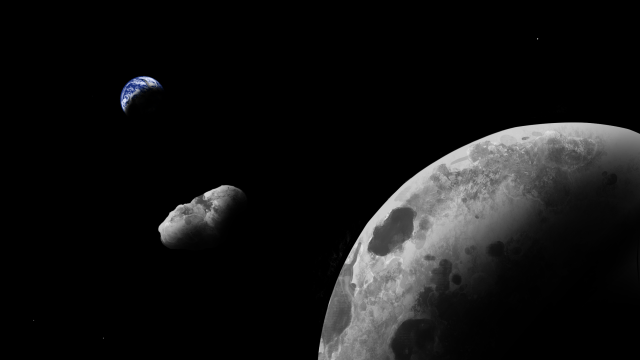Every April for the next several hundred years, a small asteroid is visible to a select few telescopes on Earth. That asteroid is Kamo’oalewa, a space rock that a team of astronomers says is likely an ancient fragment of our Moon.
The astronomers recently observed the extremely faint Kamo’oalewa through the Large Binocular Telescope in Arizona and analysed the way light reflected off it. They found that the asteroid’s spectra matched lunar rocks from NASA’s Apollo mission, a strong indicator that the rock is actually Moon rock. Their results are published today in Communications Earth & Environment.
“I looked through every near-Earth asteroid spectrum we had access to, and nothing matched,” said Benjamin Sharkey, lead author of the paper and an astronomer at the University of Arizona, in a university release.
Kamo’oalewa is a Hawaiian word that alludes to the object’s oscillating visibility in the sky; in April you see it, and then you don’t. The asteroid doesn’t inhabit the solar system’s main asteroid belt between Mars and Jupiter, as most do. Instead, this particular 60.96 m object is a quasi-satellite, meaning it’s a near-Earth asteroid that does orbit the Sun but is closer to Earth than other asteroids. (In this case, close means about 9 million miles from our planet; the Moon is about 402,336 km away at its farthest.)
The rock was originally discovered in 2016 by the PanSTARRS telescope in Hawaii. Sharkey’s team spent the next three years investigating Kamo’oalewa’s origins, with some hiatus due to telescope closures caused by the covid-19 pandemic. They took their final data this spring, some “much needed follow-up observations,” Sharkey said in the release, adding that the asteroid “is easier to explain with the Moon than other ideas.”
They compared the asteroid’s reflected light with the way other near-Earth asteroids reflect light, and the Apollo rocks were the nearest match. Besides the light reflectance data, the team said there were other characteristics of Kamo’oalewa that set it apart, like its location in space.
“It is very unlikely that a garden-variety near-Earth asteroid would spontaneously move into a quasi-satellite orbit like Kamo’oalewa’s,” said co-author Renu Malhotra, a planetary scientist at the University of Arizona, in the same release. Malhotra’s lab is separately working to determine the asteroid’s origins (that is, when and how exactly it broke away from the Moon).
Malhotra added that Kamo’oalewa’s current orbit will last. Her team estimates the entered its current orbit around 500 years ago and has about 300 years left there. So if we’re going to confirm that the rock is a slice of the Moon, we’ve got three centuries to do it.
Unlike this nearby rock, most asteroids are thought to have formed in the very early years of the solar system, when the planets were coalescing. A NASA mission called Lucy launched last month on a journey to study a group of them called the Trojans, in an effort to learn more about what conditions were like billions of years ago.
